
How to “Read” a Bison: Basics for Visitors
Bison are some of the most iconic animals in Yellowstone. While they may appear docile, bison do not view individual humans as a significant threat. Their immense size and strength mean they can be dangerous if provoked, and we humans tend to forget how fragile we really are in comparison. A lack of healthy caution while admiring wildlife can lead to risky encounters. Understanding bison behavior not only enriches your visit but also ensures your safety. Here’s a simple guide to help you decode their body language and actions.
Bison Talk with Their Bodies

Head Movements:
A bison lowering its head or swinging it side to side is a clear warning. This movement means it feels threatened or is ready to defend itself. Tossing its head or showing its horns is like flashing a neon sign that says, “Back off!” These are not friendly gestures—it’s time to give them space.
Posture:
Bison use their posture to communicate confidence and dominance. If you see one standing tall and broad, especially if it positions itself sideways, it’s asserting control and reminding you that it’s in charge.
Tail Position:
The position of a bison’s tail is a great indicator of its mood. A calm bison’s tail hangs low and relaxed. However, if its tail is up in the air like a flag, it’s on high alert and might charge. That’s your cue to back away immediately and get out of there!
Sounds They Make:
Grunts:
These are normal communication sounds between bison, almost like casual chatter. If you hear them grunting, it usually means they’re comfortable and interacting with the herd. (Sounds like a burp.)
Snorts:
A snort is a warning sound. It’s the bison’s way of saying, “Stay back!” If you hear this, it’s best to put some distance between you and the animal. (Sounds like a growly pig pushing air through its nose.)
Bellows:
During the summer mating season, called the rut, male bison (bulls) bellow loudly to impress females and warn rival males. These booming calls are nature’s way of announcing strength and dominance. (Sounds like a roaring fart.)
What They Do in Groups:
Follow the Leader:
Bison herds are often led by dominant females who decide where the group will graze and move. Watching them interact can give you a sense of their social structure and teamwork.
Big Bull Fights:
During the rut (June-September), bulls fight each other to prove who’s strongest and earn mating rights. These battles look intense, with headbutting and locking horns, but it’s all part of their natural behavior. While viewing bison at 25 yards is generally safe outside the breeding season, it’s wise to increase this distance during the rut to avoid inadvertently becoming part of a bull contest.
Daily Life of a Bison:
Grazing:
Bison are nomadic grazers, spending most of their day eating grass and moving to find the best patches. Their constant movement keeps the herd fed and ensures they don’t overgraze any one area.
Dust Baths (Wallowing):
Rolling in the dirt, or wallowing, is a favorite activity for bison. It helps them get rid of pests like ticks, keeps their skin healthy, and cools them down during warm weather. These shallow depressions they create in the ground are easy to spot across the plains.

How to Stay Safe Around Bison:
Respect Their Speed:
Despite their size, bison can run up to 35 mph—faster than you might think! Never assume they’re slow or sluggish just because they’re a large animal or grazing quietly.
Read Their Focus:
If a bison looks at you and seems to be paying close attention, it’s time to back away. This focused behavior often precedes a charge, especially if you’ve gotten too close.
Keep Your Distance:
Always stay at least 25 yards (roughly two bus lengths) away from bison. This distance keeps you safe and prevents the bison from feeling threatened. Remember, they’re wild animals, not pets or livestock here.

Understanding these basics can help you enjoy the beauty and majesty of Yellowstone’s bison safely and respectfully. Take time to observe their fascinating behaviors from a safe distance, and you’ll leave with unforgettable memories of these incredible animals—instead of unforgettable traumas and wounds.
Written By
Brandon Lewis
Brandon Lewis joined the Draper Museum’s staff in spring 2014 after interning for two summers with the Draper Museum Raptor Experience. Lewis’s duties include presenting raptor education programs for the public, training raptor program volunteers, developing an animal enrichment program, and caring for, feeding, cleaning up after, and training the birds currently living at the Buffalo Bill Center of the West. Lewis has dual degrees in zoology and history from the University of Wyoming. In addition to working with birds of prey, he has a background in public education working as a Park Guide for the National Park Service, and has interpreted American history in period clothing for the past ten years.
